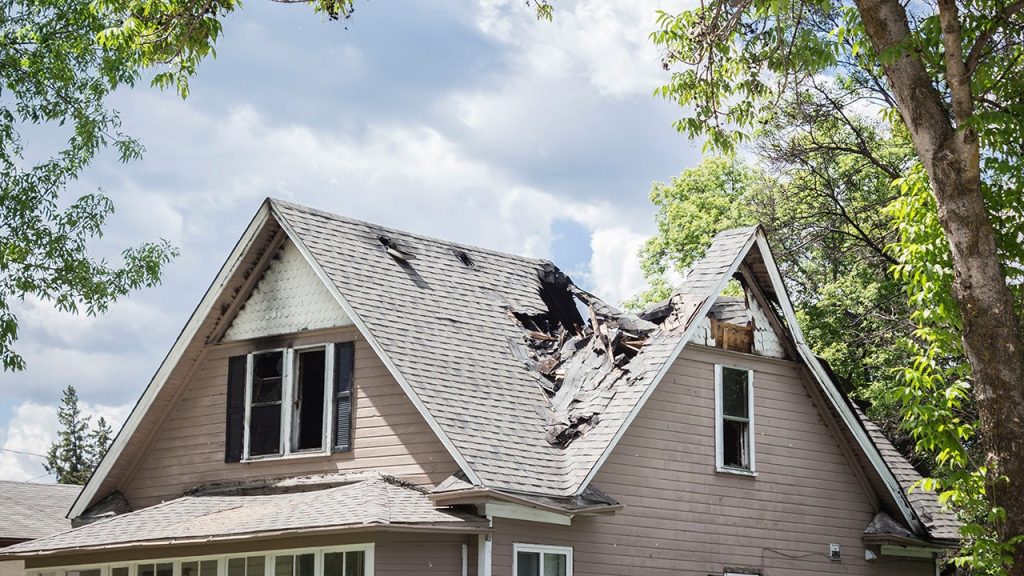Key takeaways
- Loss of use reimburses expenses incurred when your home is uninhabitable after a loss.
- Elective renovations and general maintenance are not covered by loss of use.
- Pet boarding, parking fees, moving expenses and laundry services are just a few of the expense loss of use may cover.
When disaster strikes and your home becomes uninhabitable, the last thing you want to worry about is where you’ll live and how you’ll cover the unexpected costs. This is where loss of use coverage comes in. Whether it’s a fire or another covered peril, this component of homeowners insurance helps ensure that you and your family can cover temporary living arrangements and have your essential needs met while your home is being repaired or rebuilt. Bankrate can help you understand the ins and outs of loss of use coverage so you can have peace of mind when you need it most.
What is loss of use coverage?
Also known as additional living expenses (ALE), loss of use coverage is part of a standard homeowners insurance policy. Your policy also lists this protection as Coverage D.
Loss of use coverage pays for essential costs while you aren’t able to live in your home due to a covered claim. Instead of paying out of pocket for things like an extended hotel stay and daily restaurant visits, loss of use coverage is designed to reimburse you for those expenses.
Loss of use coverage only applies when your home is damaged in a covered peril. For example, if your home was severely damaged in a flood, loss of use coverage wouldn’t apply because home insurance doesn’t cover flood damage and flood policies exclude loss of use coverage.
There are also specific limits for this coverage. If you’re wondering how to calculate loss of use for your home insurance policy, you should understand that the coverage will be a percentage of your dwelling coverage limit. For example, your policy may only carry up to 30 percent of your policy’s dwelling coverage, which could be up to $90,000 on a $300,000 policy. Be sure to talk to your insurance provider about your policy and what kind of coverage is adequate for your needs. Having higher limits could result in the cost of your homeowners insurance increasing, but provide more protection.
How does loss of use coverage work?
Say a major portion of your house gets burned down in a wildfire, rendering it uninhabitable for some time. Your homeowner’s policy would cover the cost of the rebuild, as well as any personal belongings that perished in the fire. In addition, your loss of use coverage would help pay for your temporary living expenses, like hotel or Airbnb stays, food, pet boarding, parking fees and other reasonable expenses.
Your insurance company may handle your loss of use payment in a few ways. Some insurance companies like Safeco may be able to offer immediate assistance through an advance against your claim’s settlement, while others may help you find and pay for a rental property or other temporary lodging.
In the meantime, you should keep track of all receipts for your normal living expenses so you can be reimbursed by your insurance company later through your claim’s final settlement.
What does loss of use coverage cover?
Loss of use coverage reimburses you for most living expenses to maintain your normal living standard while you’re unable to live in your home due to a covered peril. The basic coverages include:
- Residency expenses such as motels, hotels, rentals or an apartment
- Expenses associated with moving your items to storage
- Fuel expenses if extending your work commute
- Parking fees if you move to a temporary residence that requires it
- Laundry expenses if you don’t have access to a washer or dryer.
- Pet boarding fees if you have to use pet boarding while you await repairs.
- Excess of normal fees for meals (say you normally cook at home but are unable to at your temporary place and have to eat at restaurants instead)
Every insurer offers slightly different coverage types, so check with your insurance provider to see which items they cover under your loss of use policy. You should also find out if there are any limitations, like a maximum benefit amount for temporary living expenses. Shopping around to find the best homeowners insurance company for your needs is one of the best ways to ensure you’re getting the right coverage.
Most insurance companies provide loss of use coverage at 10-30 percent of your dwelling’s insured value. So, if your dwelling coverage (or coverage A) is at $300,000, then your loss of use benefits cap between $30,000 and $90,000. However, a few insurers may have unlimited loss of use coverage limits, so check your policy declarations page to see how your insurance applies.
Loss of use coverage for condos
Loss of use coverage works similarly for condo insurance. If your condo unit is damaged and you have to relocate, you would receive additional living expenses coverage through your HO-6, condo policy. To calculate your loss of use coverage limit, some insurance companies may combine your dwelling’s value with your personal property coverages.
Loss of use coverage for rentals
The same coverage applies to renters insurance policies in that the loss of use coverage helps you maintain your standard of living while you wait to move back into your rental. Insurance companies calculate your coverage limits based on a percentage of your personal property coverage.
In other instances, renters insurance companies may pay you a flat amount as outlined in your policy. It’s a good rule of thumb to speak with your insurance provider to learn more about how they calculate your benefit amount.
Loss of use coverage for mobile homes
Loss of use coverage for mobile homes functions similarly to coverage for traditional homes, providing financial support for additional living expenses if your mobile home becomes uninhabitable due to a covered peril. This coverage typically helps pay for temporary housing and other necessary costs incurred while your home is being repaired or replaced, up to your policy limit.
Given the unique nature of mobile homes, such as their susceptibility to certain types of damage and potential difficulties in relocation, it is crucial to review the specifics of your policy to ensure it provides adequate protection and understand any exclusions or conditions that may apply.
What does loss of use coverage not cover?
Insurance companies will typically help you pay for most of the expenses related to your temporary living situation. However, loss of use coverage doesn’t cover everything. Most notably, you can only utilize loss of use coverage if your home is damaged by a covered peril.
For example, damage caused by flooding or an earthquake isn’t covered by home insurance. Therefore, loss of use coverage wouldn’t apply if your home was severely damaged by either event. Loss of use coverage also can’t be used for things like elective renovations or general maintenance.
Most insurance companies have a list of excluded expenses. If you have to file a claim, make sure you know what those exclusions are. That way, you can make informed spending decisions, knowing what is and isn’t covered.
How to get reimbursed for additional living expenses
If you have to use your additional living expense coverage, there are some things you can do to expedite the claims process:
- Save receipts for all essential expenses. Expenses including rent or hotel bills and moving costs can be covered by your loss of use coverage. Additionally, expenses like eating out at restaurants, boarding your pets, and any other costs that you incur may also be covered. Include receipts to help expedite the claims process.
- Check with your property insurer. When you file a claim, ask your insurance company about its claims process. Find out how long it usually takes to process, approve and reimburse your claim.
- Begin your claim. Depending on what your insurer offers, you can start to file your claim either online, in person, or over the phone. Most insurance companies have an online portal that allows you to upload relevant documents in a secure manner.
- Upload documentation. Most companies allow you to upload any supporting documentation that may be required, such as receipts and pictures.
- Make a checklist. Pay attention to any documentation the insurance company requires, and make a checklist of every step, so you don’t miss anything important.
If you forget a step or don’t provide all the required information, your claim could be delayed.
Frequently asked questions
-
-
Loss of use coverage in homeowners insurance has several limitations that policyholders should be aware of. Primarily, it covers additional living expenses incurred if your home becomes uninhabitable due to a covered peril, such as fire or storm damage, but only up to the policy’s specified limits and duration. This means there is a cap on the amount the insurance will pay and a time limit on how long the benefits are available. Loss of use coverage typically does not cover expenses beyond necessary living costs, such as mortgage payments, utilities or property maintenance costs that continue despite the displacement. Additionally, it won’t cover loss of income from rental properties if you are a landlord, unless you have additional loss of rental income coverage.
-
Yes, loss of use coverage is included in most homeowners insurance policies, except the HO-1 policy form. In order to use your loss of use coverage, your home must be damaged by a covered peril. If your claim is denied, you can’t utilize your loss of use coverage.
-
A home insurance deductible generally applies when filing a claim, but you do not have a separate deductible for loss of use coverage. The cost of your living expenses will be reimbursed up to your policy’s limit and insurer’s approval of your expenses.
-
If the part of your home you rent out is included in the claim, you may be able to get fair rental value from the loss of use coverage. The fair rental value is the rental income amount you may lose by the house being uninhabitable. There may be exclusions and limitations on your policy, so be sure to speak with your insurance agent about the correct coverage if you rent out a portion of your home.
-
If access to your home is prohibited by a governmental authority, this is included as part of your loss of use coverage. For example, if your neighborhood is affected by a tornado or hurricane, but your home is not affected, you may be prohibited from entering the neighborhood until cleanup efforts can be completed. This differs from additional living expenses coverage, which requires your home to be damaged in a covered loss. With prohibited access, your home is not damaged, but your neighbors’ are. You can still file a claim under your loss of use coverage for expenses you incur staying elsewhere until you are allowed back into the neighborhood.
-
Read the full article here
















